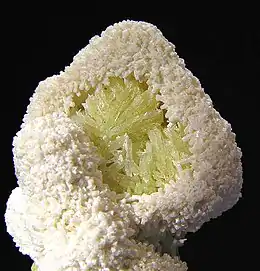Shortite
Shortite is a sodium-calcium carbonate mineral, with the chemical formula Na2Ca2(CO3)3. It was discovered by J. J. Fahey in well cuttings from the Green River Formation, Sweetwater County, Wyoming, US, and was named to honor Maxwell N. Short (1889–1952), Professor of Mineralogy, University of Arizona.
| Shortite | |
|---|---|
 | |
| General | |
| Category | Carbonate minerals |
| Formula (repeating unit) | Na2Ca2(CO3)3 |
| Strunz classification | 5.AC.25 |
| Crystal system | Orthorhombic |
| Crystal class | Pyramidal (mm2) H-M symbol: (mm2) |
| Space group | Amm2 |
| Identification | |
| Colour | Colourless, light yellow, light green |
| Cleavage | Distinct/Good On {010} |
| Fracture | Conchoidal |
| Mohs scale hardness | 3 |
| Lustre | Vitreous |
| Diaphaneity | Transparent |
| Specific gravity | 2.6 |
| Density | 2.6 |
| Optical properties | Biaxial (-) |
| Refractive index | nα = 1.531 nβ = 1.555 nγ = 1.570 |
| Birefringence | 0.039 |
| Dispersion | r < v moderate |
Shortite is associated with commercial trona ores, and some care must be taken when beneficiating crude trona to avoid contamination with shortite.[1]
References
- McKetta, John J. (1995) "Slurry Systems, Instrumentation to Solid–Liquid Separation", Encyclopedia of Chemical Processing and Design, ISBN 0-8247-2602-2
This article is issued from Wikipedia. The text is licensed under Creative Commons - Attribution - Sharealike. Additional terms may apply for the media files.
